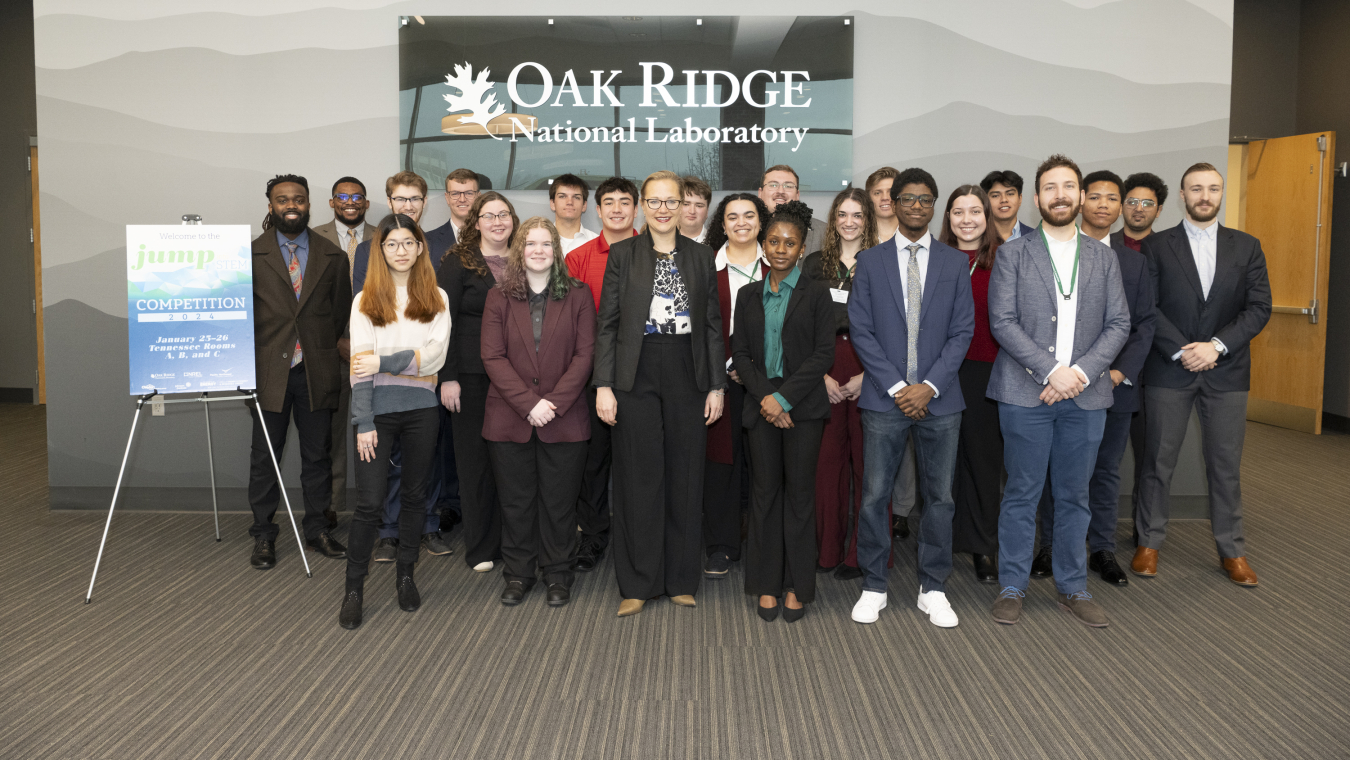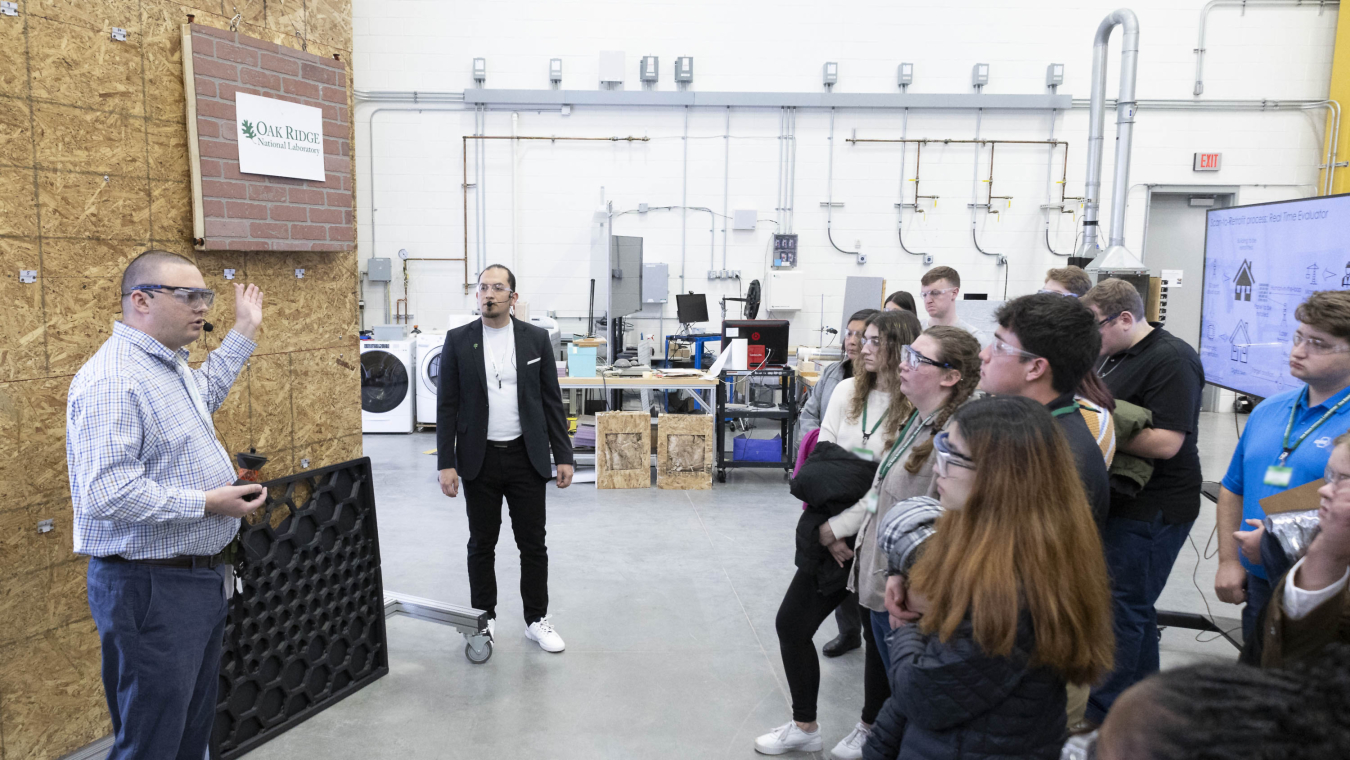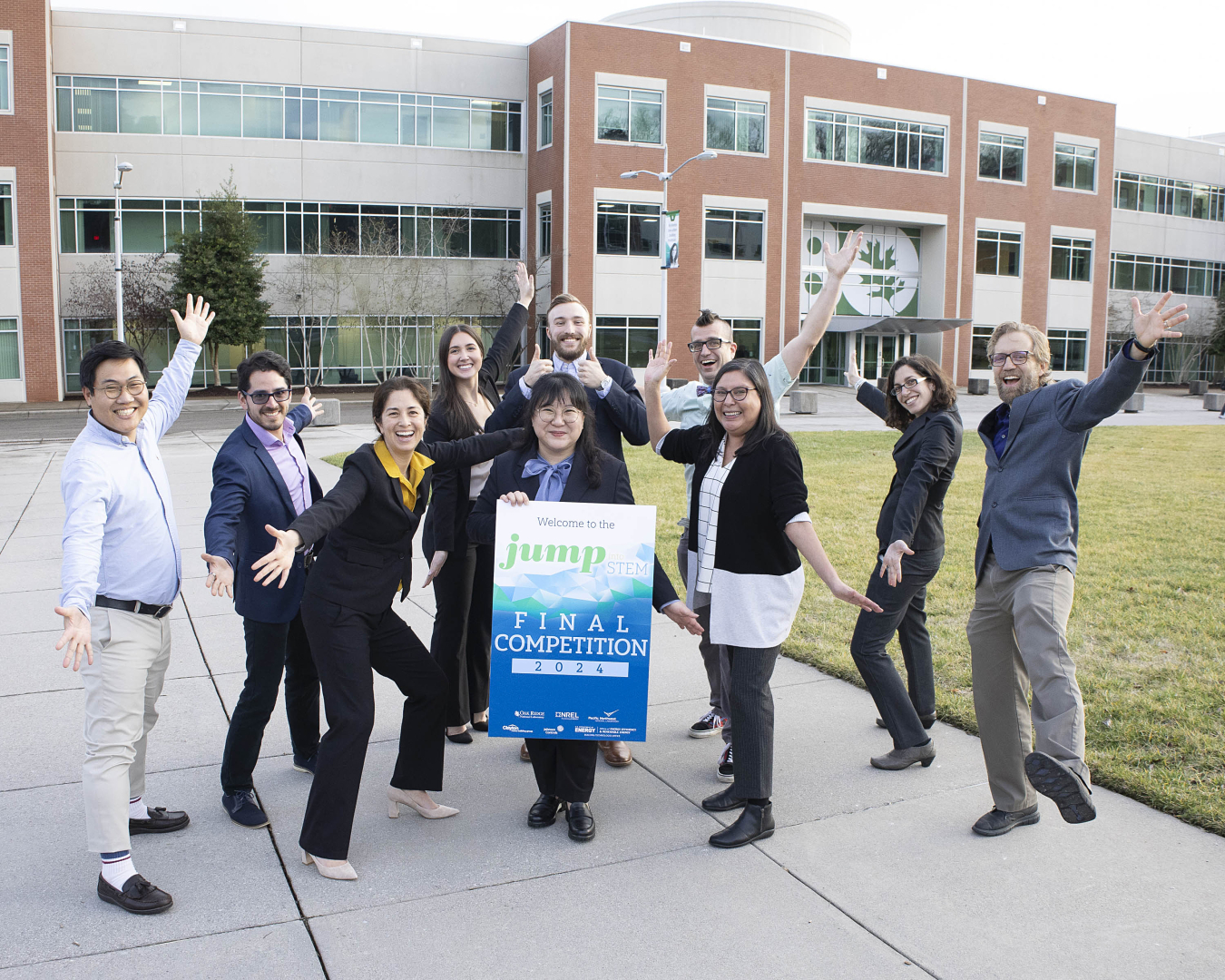Building science students will spend 10 weeks this summer interning at national laboratories as winners of EERE’s Building Technologies Office (BTO) sixth annual JUMP into STEM finals competition.
February 21, 2024
Mandy Mahoney, (front row, third from left), director of the DOE Office of Energy Efficiency and Renewable Energy’s Building Technologies Office, welcomed 21 students representing seven universities across the nation to the sixth annual JUMP into STEM finals competition at Oak Ridge National Laboratory.
Building science students will spend 10 weeks this summer interning at national laboratories as winners of the Department of Energy’s Office of Energy Efficiency and Renewable Energy’s (EERE’s) Building Technologies Office (BTO) sixth annual JUMP into STEM finals competition.
Nine student teams were selected to participate in the finals, which were hosted at Oak Ridge National Laboratory January 25–26, 2024. The students pitched their innovative solutions for thermal energy storage, building envelope improvement, and carbon reduction. Judges included buildings experts from academia, national laboratories, and industry.
The four winning teams and the names of their projects include:
- University of Nebraska, Lincoln – Izzi Bryant, Maddax Frye, Ema Horner, and Sophie Kudron, “Detecting, Contracting, Sealing (DCS) – the Community Envelope.”
- Purdue University – Andreas Hoess, Aaron Farha, Levi Premer, and Rebecca Lu, “Reducing Barriers to Achieve an Energy Efficient Lifestyle for Low-Income Families in the United States of America.”
- Worcester Polytechnical Institute – Rebekah Shields, “KILN Thermal Energy Storage.”
- Embry-Riddle Aeronautical University – Spencer Marinac and Jared Williams, “Energy Saving Solutions: Multi-Split Thermal Energy Storage System.”
“It’s exciting to see the ingenuity from this next generation of building scientists,” said Mandy Mahoney, BTO director, who delivered opening remarks at the final competition. “These student innovations will be essential to help us achieve the rapid decarbonization of the U.S. building stock by 2050 while bringing benefits to every community in America.”
“I congratulate all the teams that made it to the finals and look forward to seeing the winning team members this summer during their internships, when they will experience firsthand how national laboratories accelerate ideas through research, development, and deployment,” she said.
Students will have the opportunity to intern at JUMP into STEM sponsoring national laboratories: four at ORNL in Oak Ridge, Tennessee; four at the National Renewable Energy Laboratory, or NREL, in Golden, Colorado; and three at Pacific Northwest National Laboratory, or PNNL, in Richland, Washington. In addition, JUMP’s industry partner collaboration program, which was launched in 2023, will continue in 2024 and has expanded engagement opportunities. This year, all interns will be invited to spend two days with industry partners Johnson Controls or Clayton Home Building Group, where they will learn how building science technologies are implemented in the real world.
JUMP (Join the discussion, Unveil innovation, Make connections, Promote tech-to-market) into STEM (Science Technology Engineering Math) is a building science competition for undergraduate and graduate students at U.S. colleges and universities. A DOE-funded initiative, the program seeks to inspire the next generation of building scientists, focusing on creativity and diversity in the building science field. The program attracts students from traditional building professional degrees of civil and mechanical engineering as well as from other majors, such as computer science, data science, statistics, mathematics, physics, economics, sociology, meteorology, architecture, and other engineering disciplines.
“Each year, the student pitches continue to be impressive, and the competing teams continue to excel in meeting the challenges,” said Yeonjin Bae, ORNL’s JUMP into STEM program lead. “We appreciate the enthusiasm of the students and the support of the professors and industry partners, whose mentorship and guidance help to make the competition possible.”
Student teams presented 20-minute pitches addressing one of the following challenges:
- Keepin’ it Cool (or Hot) – developing a solution for thermal energy storage for buildings to optimize energy utilization, enhance sustainability, and increase resilience.
- That’s A Wrap! – improving the building envelope performance of new or existing residential buildings by reducing energy consumption in a cost-effective and accessible way.
- You and Me, Carbon Free! – developing a solution that will reduce carbon emissions from U.S. buildings such as residential, commercial, new, or existing.
“JUMP into STEM gave me the unique opportunity to extend my horizon in the field of building technology, and at the same time it helped me to raise awareness of the needs of low-income communities,” said Andreas Hoess, a doctoral student in mechanical engineering from the winning Purdue University team. “This was a great chance to connect with researchers from the industry.”
Colleges and universities represented during the finals include Embry-Riddle Aeronautical University, the Indiana Institute of Technology, the University of Nebraska-Lincoln, North Carolina Agricultural and Technical State University, Purdue University, the University of North Carolina at Charlotte, and Worcester Polytechnic Institute. Final competition judges were from Johnson Controls, Oak Ridge Associated Universities consortium, and Vanderbilt University.
“Jump into STEM provides unique access into the cutting-edge work of the national labs and is incredibly open, warm, and welcoming to our students,” said Liane Hancock, associate professor of architecture at the University of Louisiana, Lafayette. “This program makes it clear that students have a place at DOE. The access to directors from programs and leading scientists and engineers shows just how much DOE is dedicated to bringing young people who represent the fabric of this country to the forefront of cutting-edge research on building technology.”
For more information about JUMP into STEM’s professor, student, and industry opportunities, visit jumpintostem.org.

During the two-day final’s competition, JUMP into STEM students toured the Building Technologies Research and Integration Center at ORNL where they learned about ORNL-developed technologies such as the real-time building evaluator for envelope installation.

The JUMP into STEM leadership team, representing ORNL, NREL and PNNL, celebrate the ending of a successful sixth annual competition.

